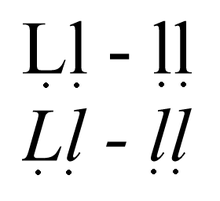Ḷ
Ḷ (minuscule: ḷ) is a letter of the Latin alphabet, derived from L with a diacritical dot below. It is or was used in some languages to represent various sounds.
- In Asturian, a digraph (Ḷḷ, lower case: ḷḷ) is used to represent some western dialectal phonemes corresponding to standard ll (representing a palatal lateral approximant [ʎ]).[1][2] Among this group of dialectal pronunciations, usually called che vaqueira, can appear basically: a voiced retroflex plosive [ɖ], a voiced retroflex affricate [dʐ], a voiceless retroflex affricate [tʂ] and a voiceless alveolar affricate [t͡s].[3] Formerly, this group of sounds were represented as lh (in Fernán Coronas's proposed writing system), ts or ŝ. However, this grapheme is used only in dialectal texts and in toponyms of western Asturias.[4] Because of the difficulties of writing it in digital texts, non-diacritical l.l (majuscule: L.l) is also often used.[5]

Ḷ
In the International Alphabet of Sanskrit Transliteration, ḷ is used to represent vocalic /l/.
Computer encoding
HTML characters and Unicode code point numbers:
- Ḷ: Ḷ or Ḷ – U+1E36 - Latin capital letter L with dot below
- ḷ: ḷ or ḷ – U+1E37 - Latin small letter L with dot below
References
- Normes Ortográfiques, Academia de la Llingua Asturiana, Oviedo/Uviéu (Spain), 2012.
- Gramática de la Llingua Asturiana, Academia de la Llingua Asturiana, Oviedo/Uviéu (Spain), 2001.
- Xosé Lluis García Arias, Gramática Histórica de la Lengua Asturiana, Llibrería Académica, Academia de la Llingua Asturiana, Oviedo/Uviéu (Spain), 2003.
- Normes Ortográfiques, Apéndiz I (p.125).
- Normes Ortográfiques, paragraph 1.1.3.1 (p.14).
This article is issued from Wikipedia. The text is licensed under Creative Commons - Attribution - Sharealike. Additional terms may apply for the media files.